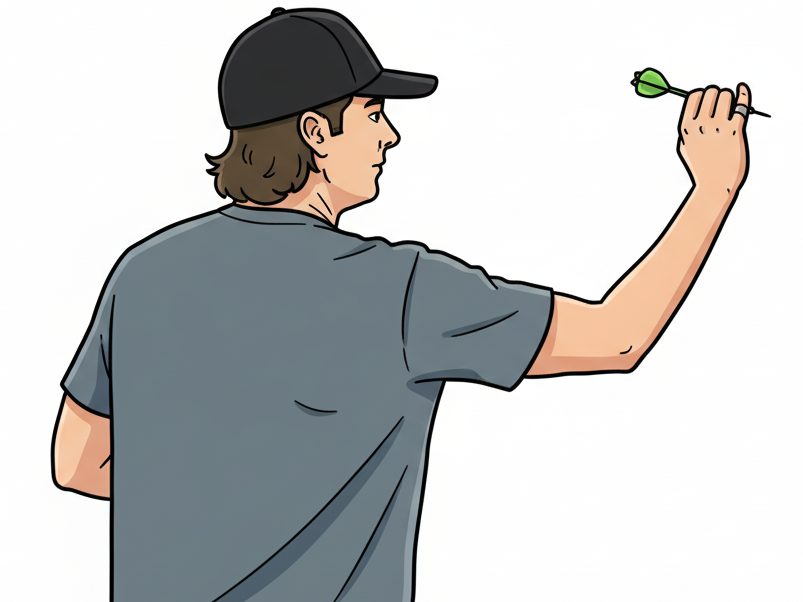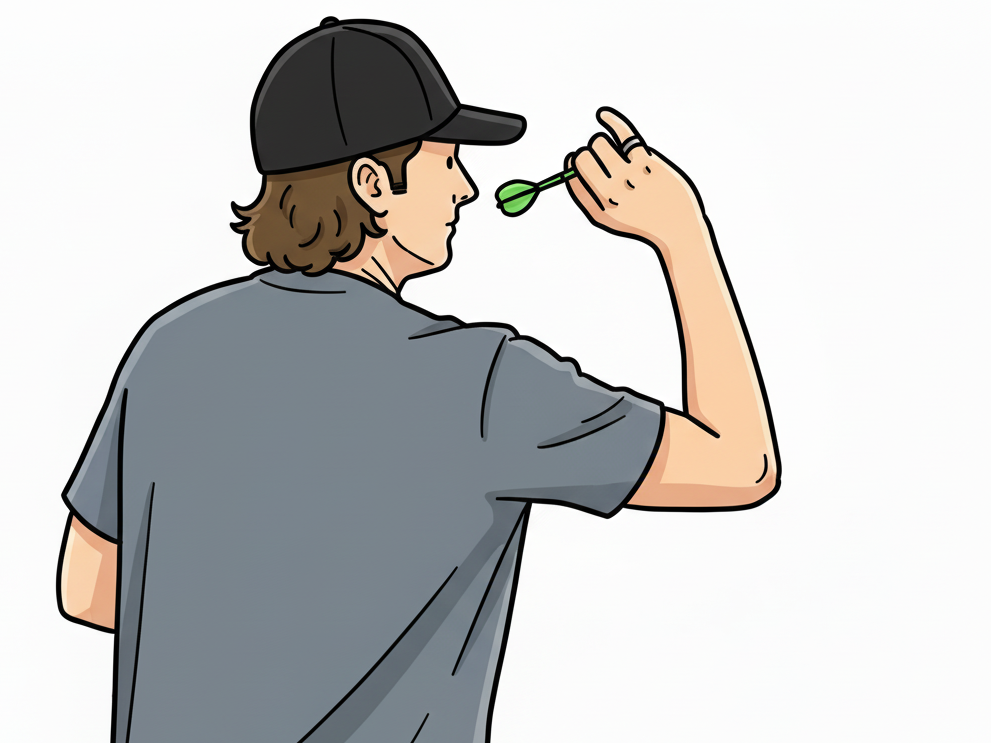Aim Before You Setup: The Pool Player's Secret to Dart Consistency
I teach pool. I've taught dozens of students over the years, and the number one thing that separates players who improve from those who plateau is understanding when to aim.
Most players aim at the wrong time. They get down in their stance, then try to figure out where to shoot. By then, it's too late - they're locked into a body position and trying to force their eyes to compensate.
The secret: Aim with your whole body before you commit to your shooting position. Then execute without thinking.
This applies to pool, darts, golf, and any precision sport. Let me show you how.
The Pool Teaching Method
When I teach pool, the first thing I tell students is never play with your phone in your pocket. But the second thing is:
"Aim while you're standing up, not while you're down in your stance."
The 3-Step Process
Step 1: Stand behind the shot
- Position your belly button on the line of the shot
- Not your eyes, not your hands - your belly button
- Your whole body is now aligned with the target
Step 2: Step into your stance the exact same way every time
- Don't adjust, don't fidget, don't "line up"
- You already aimed - now you're just getting into shooting position
- Same footwork, same body position, every shot
Step 3: Stroke without thinking
- Your body is aligned, your stance is set
- The stroke is pure execution
- Don't try to "aim better" mid-stroke
Why Belly Button Aiming Works
Your belly button is your body's centerline. When you aim with your belly button, you're aligning your entire body structure - hips, shoulders, spine - toward the target.
This is way more powerful than trying to aim with your eyes, because:
- Your body position determines your natural stroke path
- If your body is aligned, your stroke follows naturally
- If your body is misaligned, you have to compensate with your arms (inconsistent)
Visual aiming = compensating with arms/hands Body aiming = natural alignment, effortless execution
The Standing-Up Advantage
When you're standing upright, you have:
- Full range of motion to position yourself
- Unrestricted view of the table
- Freedom to move your body into alignment
Once you get down in stance:
- Limited mobility (you're locked in)
- Restricted view (head is down, eye position fixed)
- Can't reposition your body without starting over
So do the hard work (aiming) when you have freedom of movement, not when you're locked in.
The Darts Translation
The exact same principle applies to darts.
The Common Mistake (What I Used to Do)
Most players, including me until recently, do this:
- Raise dart to an extended position
- Try to "aim" the dart tip at the target
- Adjust hand position, dart angle, trying to line it up visually
- Eventually throw, hoping the aim was right
Problem: You're trying to aim from a locked position with limited mobility. Your arm is extended, your body is already committed, and you're relying purely on visual alignment.
The Correct Method (What Actually Works)
Here's what you should do instead:
Step 1: Look at the target while raising the dart
- As you slowly raise the dart to your setup position, your body naturally orients toward what you're looking at
- Unlike pool (where you stand square), in darts you're side-on, but the principle is the same - your body aligns during the raise
- Your shoulders, arm, and throwing line all naturally orient toward what you're looking at
Step 2: Settle into your setup position the exact same way every time
- Compact position - elbow bent, dart at eye level or just above
- This is like stepping into your pool stance - you're locking in the alignment you already created
- Brief pause to confirm you're locked in
- Don't adjust, don't "aim the dart tip" - you already aimed with your body
Step 3: Throw without thinking
- Your body is aligned, your setup is consistent
- The throw is pure execution
- Trust it
Why The Slow Raise Matters
The slow, deliberate raise to your setup position is the "standing behind the shot" phase in pool. It's where the aiming happens.
During the slow raise:
- You're looking at the target
- Your body naturally positions itself toward what you're looking at
- Your arm structure follows your body alignment
- By the time you reach setup position, you're already aimed
If you rush the raise:
- Your body positions randomly
- You reach setup position before you've aligned
- Now you're trying to aim from a locked position (too late)
The slow raise isn't "extra time to think" - it's the aiming phase. You can't skip it.
The Setup Position (Position 2 vs Position 1)
This is critical. Most players I see (and myself until recently) set up in the wrong position.

Position 1: Extended Arm Setup (WRONG)
- Arm mostly extended
- Dart held far from your body
- Trying to "line up" the dart tip with the target visually
- Looks like you're pointing at the target
Why this fails:
- Long lever = more variance
- Extended position is hard to hold steady
- You're relying on visual alignment instead of body alignment
- Long backswing required (pulling from extended position all the way back)

Position 2: Compact Setup (CORRECT)
- Elbow bent ~90 degrees
- Dart at eye level (or slightly above/below depending on your preference)
- Compact position close to your body
- Feels like you're "loading" the throw
Why this works:
- Shorter lever = more control
- Easy to hold steady
- Your whole arm structure is aimed (not just dart tip)
- Short backswing (arm already loaded, minimal pullback needed)
- Forces you to trust body alignment instead of visual aiming
Common Questions
"But I need to see the dart tip aligned with the target"
No, you don't. That's your conscious mind trying to help with something your subconscious already handled.
When you throw a ball to someone, do you line up your fingertips with their chest? No. You look at them and throw. Your brain handles the spatial math.
Darts is the same. Look at the target during your raise, settle into setup, throw. Your brain already calculated it.
"I can't hit anything if I don't aim"
You are aiming - you're just doing it at the right time (during the raise) instead of the wrong time (from setup position).
Try this test:
- Look at treble 20
- Slowly raise to Position 2 setup while looking at it
- Pause briefly
- Throw without thinking
Your dart will go way closer than you expect, even though you didn't "aim the dart tip."
"This feels wrong, like I'm not in control"
You're not in conscious control. That's the point.
Your conscious mind processes 40-50 bits per second. Your subconscious processes 11 million bits per second.
Letting go of conscious "aiming" feels like giving up control, but you're actually switching to a vastly superior control system (your subconscious spatial awareness).
It feels wrong because you're used to fighting your brain. Trusting it feels strange at first.
The Pool-Darts Connection
If you've played pool, you already know this principle. You just haven't applied it to darts yet.
Pool:
- Aim: Standing up, belly button on line
- Lock in: Step into stance (same every time)
- Execute: Stroke without thinking
Darts:
- Aim: Slow raise while looking at target (body aligns)
- Lock in: Settle into Position 2 setup (same every time)
- Execute: Throw without thinking
Golf:
- Aim: Address the ball, align body to target
- Lock in: Waggle and set (same routine every time)
- Execute: Swing without thinking
The pattern: Alignment happens before commitment. Execution happens after commitment. Trying to aim during execution breaks everything.
Implementation
Here's your new throw sequence:
-
Look at target (not at the board in general - at the specific segment)
-
Slow raise to Position 2
- Deliberate movement (not rushed)
- Body naturally orients toward what you're looking at
- This is the aiming phase
-
Brief pause at Position 2
- Compact position (elbow bent, dart near body)
- Confirm you're locked in
- Don't adjust or second-guess
-
Controlled backswing
- Elbow stays in place
- Smooth pull back
-
Release
- Natural follow-through
- Don't think, just execute
What NOT To Do
❌ Rush the raise and try to aim from setup ❌ Hold an extended arm position (Position 1) ❌ Adjust your dart angle or hand position from setup ❌ Think about trajectory or "lining up the dart tip" ❌ Vary your setup position
What TO Do
✅ Slow, deliberate raise while looking at target ✅ Compact Position 2 setup position every time ✅ Brief pause to lock in ✅ Trust your body alignment ✅ Execute without conscious aiming
Why Most Players Never Learn This
Because it feels counterintuitive at first. Giving up conscious control of "aiming" feels like you're just randomly throwing.
But after a few sessions, you realize:
- Your grouping is tighter
- Your good throws are smoother
- You're not fighting yourself
- Consistency comes naturally
The players who stick with it become consistent. The players who go back to "aiming from setup" stay stuck.
The Bottom Line
You don't aim a dart. You aim your body.
The raise is the aiming phase. Your body aligns toward the target.
The setup is the lock-in phase. You confirm alignment and prepare to throw.
The throw is the execution phase. You trust what your body already set up.
Stop trying to aim from your setup position. Start aiming before you get there.
Want more on setup mechanics? Check out our guide on the Position 2 setup position and why your pause point matters.
